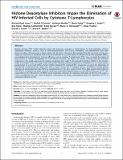Histone Deacetylase Inhibitors Impair the Elimination of HIV-Infected Cells by Cytotoxic T-Lymphocytes
Author(s)
Jones, Richard Bradley; O'Connor, Rachel; Mueller, Stefanie; Foley, Maria Hottelet; Karel, Dan; Lichterfeld, Mathias; Kovacs, Colin; Ostrowski, Mario A.; Trocha, Alicja; Walker, Bruce D.; Szeto, Gregory; Irvine, Darrell J; ... Show more Show less
DownloadJones-2014-Histone Deacetylase.pdf (6.324Mb)
PUBLISHER_CC
Publisher with Creative Commons License
Creative Commons Attribution
Terms of use
Metadata
Show full item recordAbstract
Resting memory CD4[superscript +] T-cells harboring latent HIV proviruses represent a critical barrier to viral eradication. Histone deacetylase inhibitors (HDACis), such as suberanilohydroxamic acid (SAHA), romidepsin, and panobinostat have been shown to induce HIV expression in these resting cells. Recently, it has been demonstrated that the low levels of viral gene expression induced by a candidate HDACi may be insufficient to cause the death of infected cells by viral cytopathic effects, necessitating their elimination by immune effectors, such as cytotoxic T-lymphocytes (CTL). Here, we study the impact of three HDACis in clinical development on T-cell effector functions. We report two modes of HDACi-induced functional impairment: i) the rapid suppression of cytokine production from viable T-cells induced by all three HDACis ii) the selective death of activated T-cells occurring at later time-points following transient exposures to romidepsin or, to a lesser extent, panobinostat. As a net result of these factors, HDACis impaired CTL-mediated IFN-γ production, as well as the elimination of HIV-infected or peptide-pulsed target cells, both in liquid culture and in collagen matrices. Romidepsin exerted greater inhibition of antiviral function than SAHA or panobinostat over the dose ranges tested. These data suggest that treatment with HDACis to mobilize the latent reservoir could have unintended negative impacts on the effector functions of CTL. This could influence the effectiveness of HDACi-based eradication strategies, by impairing elimination of infected cells, and is a critical consideration for trials where therapeutic interruptions are being contemplated, given the importance of CTL in containing rebound viremia.
Date issued
2014-08Department
Massachusetts Institute of Technology. Department of Biological Engineering; Ragon Institute of MGH, MIT and Harvard; Koch Institute for Integrative Cancer Research at MITJournal
PLoS Pathogens
Publisher
Public Library of Science
Citation
Jones, Richard Brad, Rachel O’Connor, Stefanie Mueller, Maria Foley, Gregory L. Szeto, Dan Karel, Mathias Lichterfeld, et al. “Histone Deacetylase Inhibitors Impair the Elimination of HIV-Infected Cells by Cytotoxic T-Lymphocytes.” Edited by Guido Silvestri. PLoS Pathog 10, no. 8 (August 14, 2014): e1004287.
Version: Final published version
ISSN
1553-7374